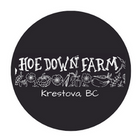June 6, 2024
Nathan Wild
FARM NEWS

Weather Woes 😓
This has been the rainiest spring we've experienced since moving here. Our spring crops have been loving it but our summer crops, such as our tomatoes, zucchini and cucumbers are way behind.
We've had four frosts after the supposed “last frost date” so it's a miracle our summer plants are still alive. Thus is farming! Every year brings a new challenge you didn't anticipate. You just gotta roll with the punches and keep moving forward.
NEW PRODUCTS

Gem Romaine Lettuce
Description: Gem Romaine lettuce are smaller lettuce head, about 2/3 the size of a full grown Romaine lettuce head.
A personal favourite of ours, Gem Romaine Lettuce have tender meaty leaves, a sweet flavour and an excellent crunch. These are a must try if you haven't had them before!
Details: sold per head. It will come in a green or red colour.

Smoothie Greens Mix
Description: Our Smoothie Greens Mix offers a blend of fresh, nutrient-dense greens that will add a boost of vitamins and minerals to your daily smoothie. Made with freshly-cut greens from our garden, this mix will provide a convenient and delicious way to nourish your body. Includes three varieties of kale, Tokyo Bekana and Mizuna.
Details: sold in a 7 oz bag.
NEW RECIPES

Spicy Peanut Noodles With Hon Tsai Tai
The more we cook with HonTsai Tai the more we love it! Its taste and texture is just like asparagus. When eaten raw it adds a wonderful fresh crunch to a dish.

Ultra-Crispy Slow-Roasted Pork Shoulder
This recipe from Serious Eats has been our go-to pork shoulder recipe for years. You can pull the pork apart with a fork when it's done! Highly recommend.
FOOD FOR THOUGHT 🍎

Conventional Food Is Losing Its Nutrients
The food being grown today is significantly less nutritious than it was in the 1950’s. A 2004 US study found important nutrients in some popular vegetables crops, from asparagus to spinach, are now up to 38% lower than they used to be.
Back in the 1950’s we didn't use nearly as many synthetic pesticides, herbicides or fertilizers to grow our food.
Farms were smaller and more diversified. We didn't have thousands of acres in monocultures like we do today. Diets were mostly regionally-based. Food was grown for flavour instead of mass-transportation and maximum shelf-life.
Our food system should be designed to maximize public health, not corporate profits.




